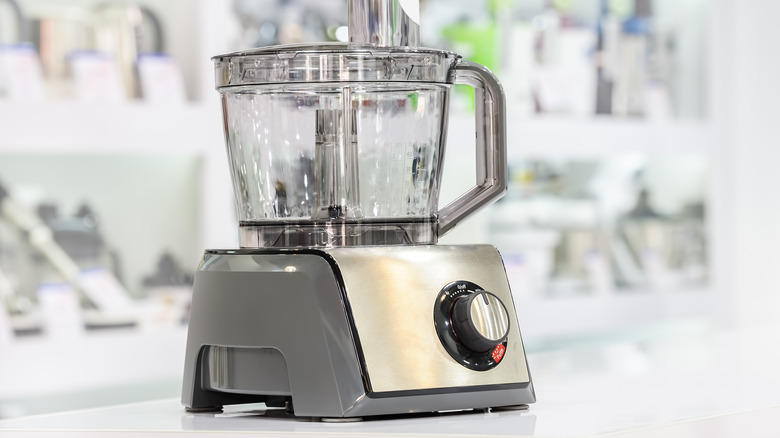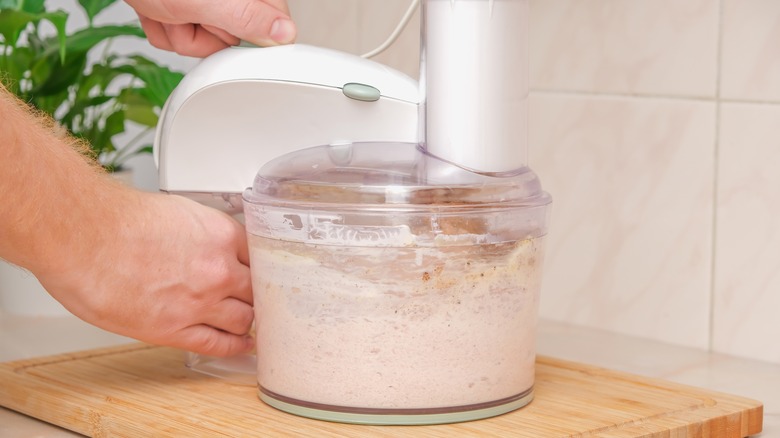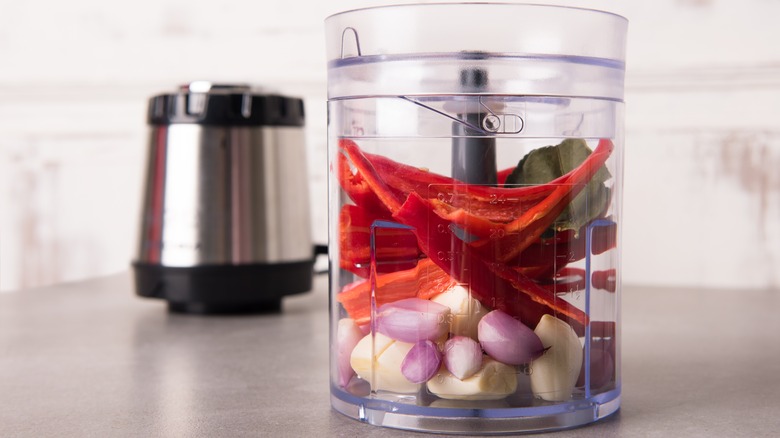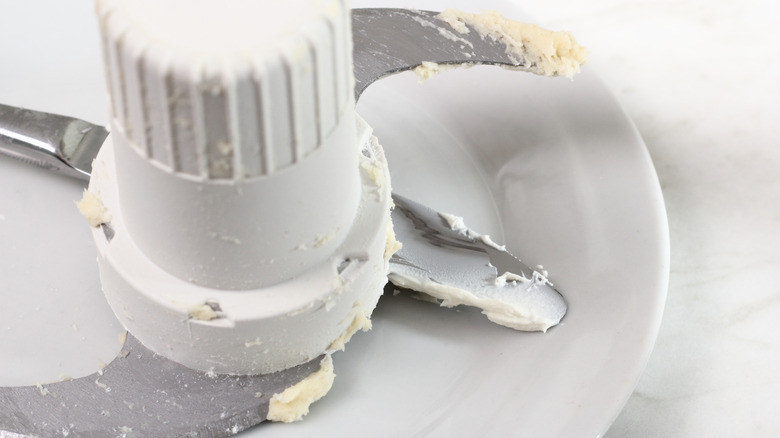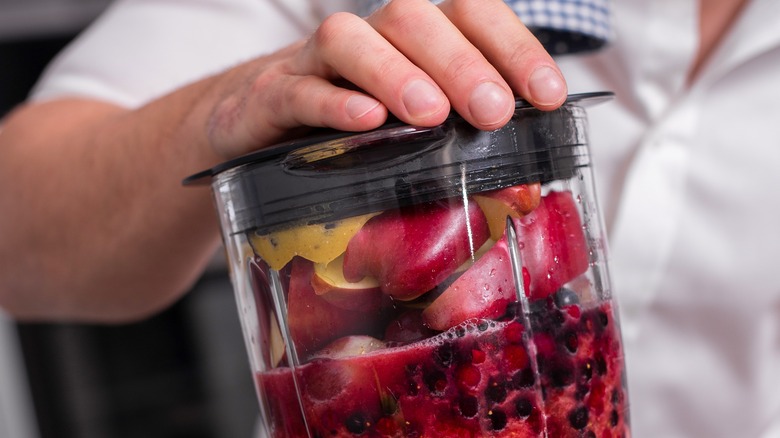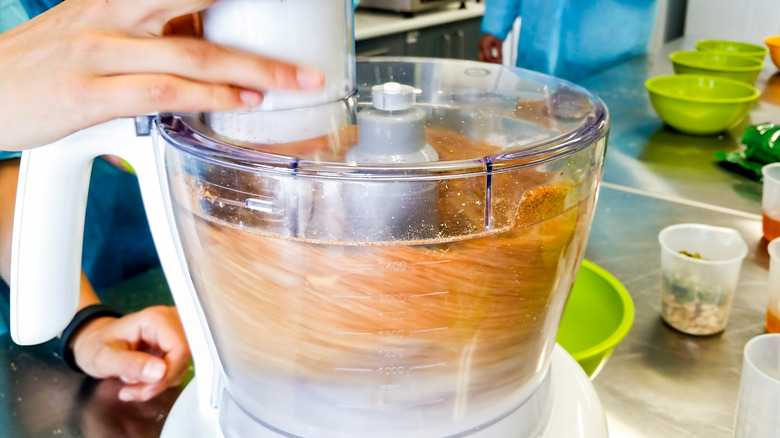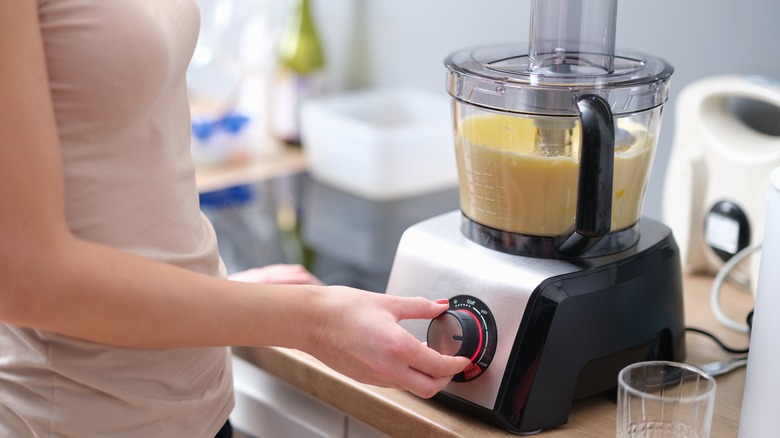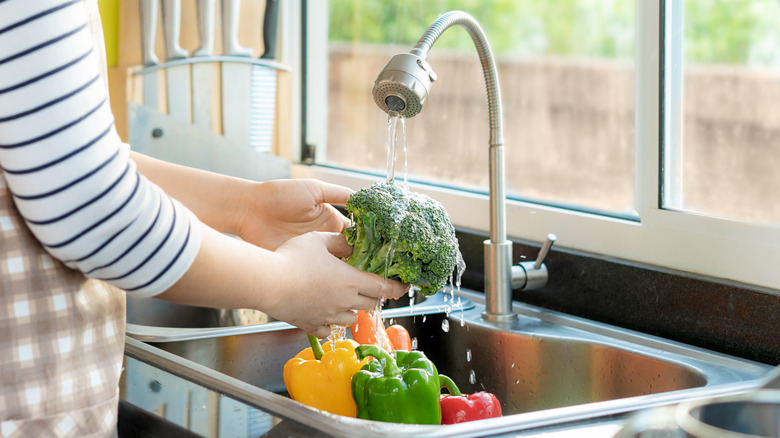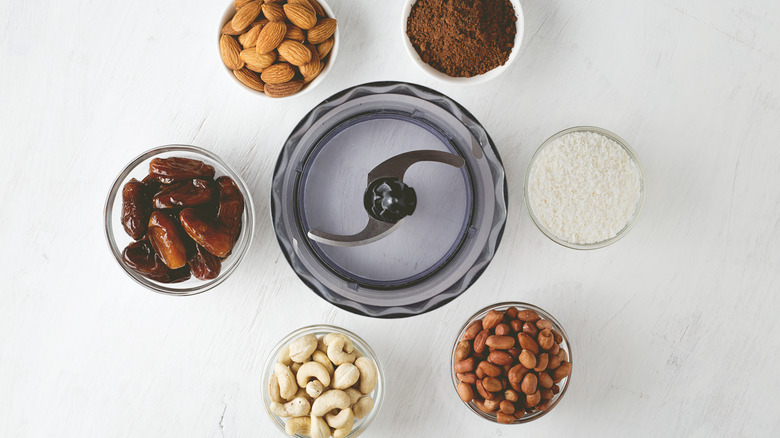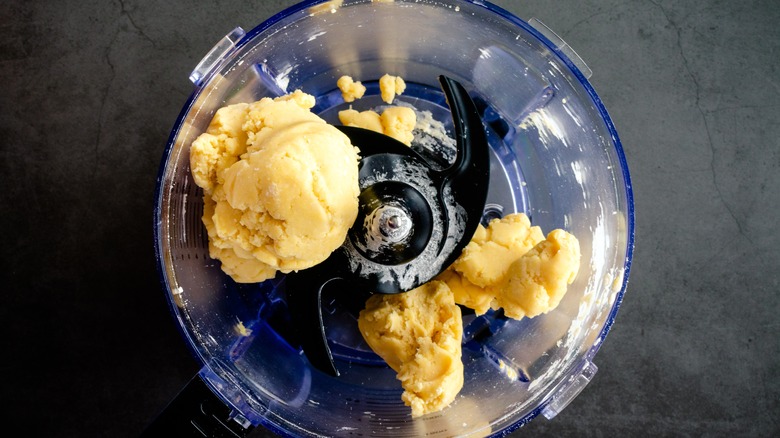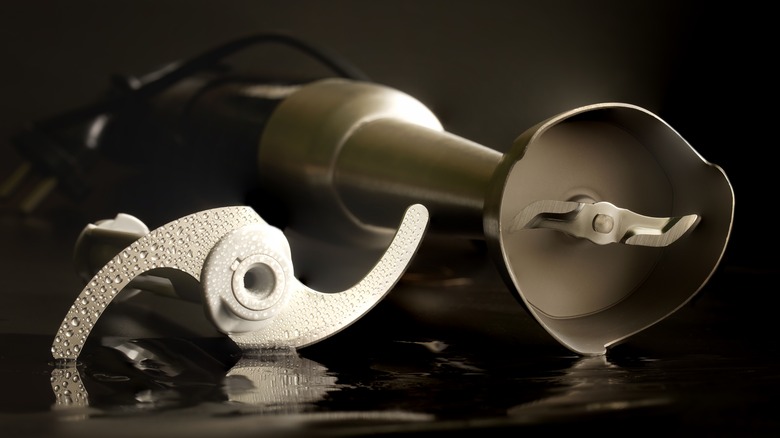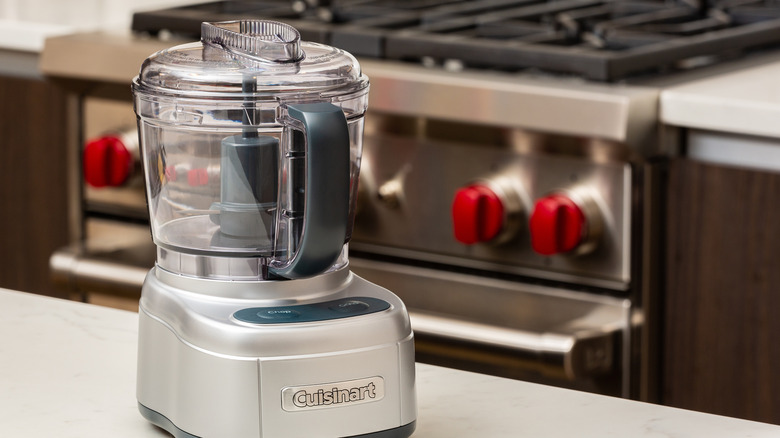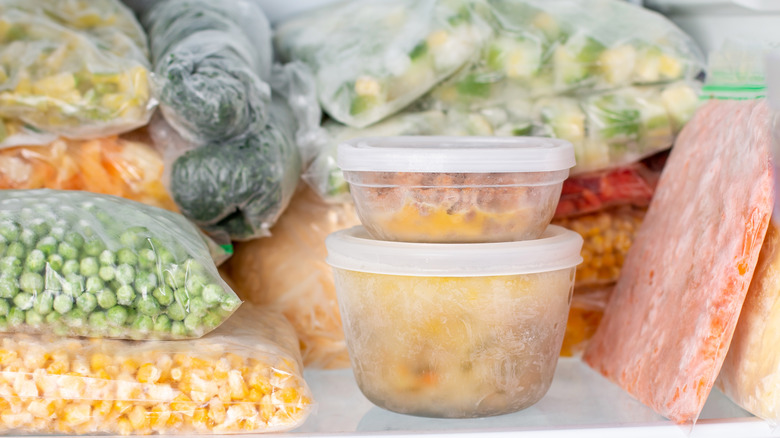Mistakes Everyone Makes With Their Food Processor
Not every kitchen gadget can withstand the test of time, but the food processor continues to be one of the most tried-and-true appliances on the market today. When Kenwood company owner Kenneth Wood first introduced the Kenwood Chef A700 to the market in 1950, he probably didn't know that he had created a kitchen appliance that would eventually become a household staple. At the time of its invention, the food processor was originally a stand mixer that set itself apart with its attachment options. What's more, unlike competitors' models, these additional accessories for the Kenwood Chef A700 that could not only slice and shred ingredients, but also peel produce and open cans (via Cook's Info).
Today, food processors are a popular kitchen appliance that many people use several times a week. The caveat, however, is that for as many uses as one can get out of their food processor, there seems to be an equal number of potential mistakes to be made when using the appliance. Everybody makes mistakes with their food processors — you've probably made a few — but there are things you can do to ensure you're treating your appliance with the care it deserves for all the work it puts in.
Buying a poor-quality food processor
When it comes to food processors, the first mistake often happens long before it has even laid claim to its designated space on your kitchen counter. While there are a wide variety of food processors on the market, you want to make sure that you're choosing the highest quality appliance for your particular needs. According to Consumer Reports, in addition to the usual features you may have already considered, there are several others to mull over.
These features include whether or not the food processor has a dough blade, multifunction accessories, a storage case, touchpad controls, a wide feed tube, varied speed settings, and a line indicating the maximum liquid you can pour into the processor. These not only ensure easier use of your food processor by ensuring you don't overfill it, but also make it easier to clean and safely store. Ultimately, the best food processors come down to what will be of use to you. You may not care for a dough blade if you never bake, but if you're going to be using it for large ingredients like potatoes, a wide feeding tube would be an asset.
Forgetting to insert blades before ingredients or using the wrong ones
It happens to the best of us: You've lovingly prepared all your ingredients, neatly packed them into the food processor bowl, and just as you go to press the start button, you notice the blades still perched on the counter. Many people have tried to wiggle the blades into the bowl after filling it. While softer ingredients may be a little more forgiving, hard and large ingredients like carrots and potatoes? Not so much.
Fortunately, you only need to remember the following sequence so you never have to deal with that hassle: base, bowl, blade — in that order (via KitchenAid). You will have to attach the food processor to its motor, secure the bowl, insert the drive adaptor, and then attach your blade. Following that, you can then add your ingredients, add the bowl cover, and choose your setting knowing that you have, quite literally, covered your bases. If you want to mince, chop, or puree ingredients like salad greens, potatoes, fruits, nuts, or legumes, the multi-purpose blade is your go-to. As the name suggests, the slicing disc is best for slicing, shedding, or grating ingredients, while the dough blade will do all the kneading when you're baking.
Failing to clean it properly
We all know that the worst part of having fun cooking in the kitchen is the clean-up. Some people might even say they'd spend more time playing in the kitchen if it meant they never had to clean up after themselves. However, if you want to keep your food processor in tip-top shape for your delicious dishes, cleaning it properly goes a long way. According to TechRadar, regardless of whether or not your food processor is safe for dishwashers for easy cleaning, it's always advised to disassemble the food processor and give the bowl and attachments a quick rinse immediately after use.
If your food processor is safe for the dishwasher, check if the user manual recommends top-shelf washing only and how sharp objects should be loaded. For handwashing, using a pair of gloves and a dishwashing brush with an extended handle is great for both safety and ease of washing. You especially want to make sure that you get all the little bits that may be lodged in that pesky spot where the bowl and blades attach. Use a bottle brush to wash smaller parts like the feed chute and a damp dish towel to wipe the base. Make sure it's completely dry before storing (otherwise it will smell rank), and if you have any doubts, leave it in a safe place to air dry.
Mistaking it for a blender and adding too much liquid
Most people have used their food processors and blenders interchangeably; however, even though a food processor is exceptionally versatile, it shouldn't be mistaken for a blender. (Blenders come with their own set of commonly made mistakes.) According to Wayfair, the key difference between these two appliances is their capacity to hold liquid. While a food processor is multi-functional and works exceptionally well for dry ingredients, a blender is specifically designed to blend solid and liquid ingredients. Blenders are able to hold larger amounts of liquids, while food processors should only really hold the bare minimum liquid needed in some recipes.
So while a blender will work great for your smoothies, soups, and dressings, a food processor will work best for non-liquid items like nut butters, chopped or minced fresh produce, shredded cheese, and dough. In fact, if you add too much liquid to your food processor, you may end up with leaks from ingredients sliding up the sides of the food processor bowl and massive flops like dry vegetables turning into pastes. Essentially, if all you're wanting is an appliance that will whip up your morning smoothies, a blender is your best bet, whereas a food processor will serve as more of a catch-all appliance for other cooking needs.
Not scraping down the sides
If you've ever thrown a couple of carrots — or any other hard ingredients — into a food processor, pressed the on button, and went shuffling around the kitchen while the processor did its thing, you'll know the result. It's usually a mix of unevenly chopped produce, with a good amount of overprocessed ingredients that have been shredded to smithereens and random chunks large enough to be a choking hazard. As culinary scientist Jessica Gavin noted, this is why using the food processor's "pulse" button and scraping down the sides of the bowl is so important.
When you use a pulse-and-scrape combination for your ingredients, especially if you're chopping fresh produce or kneading dough, you get to control the speed. You can then pause and scrape, which gets those lingering chunks on the sides of the bowl and underneath the blade, back into the mix. By the time you're done, you'll have more evenly processed ingredients, eliminating the possibility of any unpleasant surprises. And as America's Test Kitchen states, if you're ever in doubt, always under process. You can always give underprocessed food one more pulse, but you can never save a piece of shredded produce.
Forgetting to use the correct setting
While the food processor will almost always do a wonderful job of making your kitchen life easier, every single process is contingent on using the correct setting. You could have the right blades for the intended dish and hover over your processor while it does its magic, but if the setting are all wrong, you won't get the results you want. Depending on the model of the food processor, there will usually be a pulse button, which as previously noted, will run short interval bursts. The low setting will run the processor at a low speed without any pauses, while the high setting will run the processor at a high speed.
Per KitchenAid, the pulse setting works best for chopping or mincing, as does the chop setting should you have one on your food processor. Make sure that you only fill the bowl halfway to give the ingredients space as they are chopped. Additionally, pulsing is also good for kneading as you reincorporate flour into the rest of the dough.
To slice, grate, or shred, you can simply set your processor to the low or high speed and then feed your processor through the chute while it runs. A continuous run will work for purees so you can add ingredients in stages, though you may also have a puree setting on your food processor.
Not prepping food before it goes in
In addition to preparing your processor by cleaning it well and using the right settings, you want to make sure that you also prepare the actual food items you'll be processing. As always, if you're processing fresh produce, make sure you first give it a good wash. Depending on the produce, peel and shell when necessary and remove seeds if there are any.
If you're slicing or shredding long produce like carrots, make sure they will fit vertically into the feeding chute. If they're too big, cut them in such a way that they will still fit into the chute vertically (via KitchenAid). Round foods should be cut in halves or quarters. Small ingredients can be fed into the chute either vertically or horizontally but in layers. To slice or shred cheeses, meat, or poultry, first ensure that the ingredients are very cold (ideally, cheese should be frozen), and when necessary, cut them into pieces so they will fit into the feeding chute. If you're shredding spinach or other types of leaves, stack, roll, and then stand them up in the chute.
For all ingredients, once they're in the chute, you'll want to apply an even amount of pressure as you run the processor.
Adding all the ingredients at once instead of at different times
Please don't subscribe to the idea of always dumping all of your ingredients into the food processor at once. According to Cooks Info, the only time you should ever add different types of ingredients in the food processor all at the same time is if you're making a soup or a pesto. The reason why comes down to texture; different textures will call for different levels of pulsing, and as such, it is crucial that you add your ingredients to the processor at different times.
Generally, you want to first ascertain which ingredients you want to be pureed, which you want to be finely chopped, and which ones you want to be only coarsely chopped. Once you have a good idea of this, you add the ingredients you want to be pureed to the food processor first. Give them a good pulse, and then add those you want finely chopped. Pulse and repeat until all ingredients have been added.
Make sure you also consider the texture of the ingredients themselves. If some ingredients are harder than others, you'll want to make sure you adjust for that too.
Using the dough blade
This may be contentious advice, because why do manufacturers make dough blades if you're going to be advised not to use them? Well, dough blades just weren't designed for every type of dough. Per Cook's Illustrated, it seems some food processors like the Cuisinart Custom 14-Cup Food Processor recommend using the dough blade only if the recipe you're using calls for at least 3.5 cups of flour. The dough blade reportedly performs better when used for kneading dough for recipes with greater amounts of flour.
However, it's purported that metal blades may be better at kneading dough than dough blades because the latter have shorter arms, which means they don't reach the outer parts of the bowl as well. Ultimately, if your food processor has dough blades, check the user manual for specific instructions. If none are specified, experiment with varying amounts of flour and give metal blades a try instead.
Putting blades in the dishwasher
If your dishwasher allows sharp objects, you may be tempted to simply place the blades right in there with the rest of your food processor accessories. However, according to My Budget Recipes, you may not want to. As it turns out, even though it takes a while, regular use over time will result in wear and tear, as is the case with all other sharp kitchen tools. Other factors that may contribute to the blades dulling include not storing them properly, poor practices regarding usage, and unchecked washing habits.
This is where issues with the dishwasher come in. Dishwashers can compromise the sharpness of the blades because of high temperatures, harsh water spraying, and abrasive detergents. While these factors may work well for dishes with smooth surfaces like plates and glasses, given that blades have a number of edges, they're more susceptible to corroding. As such, you may want to avoid placing the blades in the dishwasher at all, even if you technically can clean them in the dishwasher. If you hand wash the blades, make sure you similarly steer clear of abrasive soaps.
Not letting the food processor cool down if it overheats
Most people are accustomed to the occasional overheating of a phone, tablet, or laptop, and as you may have guessed, food processors can overheat too. This is why most food processor brands have taken measures to prevent this, per Kitchen Seer. Armed with overheat protection sensors, these products will often automatically switch off if the motor suddenly has a spike in temperature.
Unfortunately, if you're not aware that this may be why your appliance shut off, you may register it as a glitch and switch your processor back on. This runs the risk of damaging your appliance. As such, the next time you suspect that your processor is overheating or it shuts itself off, check the user manual to learn how long you should wait before turning it back on. If there's no way of telling, a useful practice is to unplug it and let it cool for about 20 to 30 minutes. Then take off the bowl, and feel the base. If it still feels warm, let it rest a while longer. Otherwise, you can go ahead and reattach the bowl, plug it in again, and continue use.
Adding very hard frozen foods to the processor
On those days when you've forgotten to thaw your frozen ingredients in the refrigerator, you may wonder what's the worst that could happen if you placed frozen and hard produce into the food processor. According to My Budget Recipe, there's quite a bit that could go wrong. The bowl could get dented or cracked, the blades could dull faster, and, worse, the motor of your food processor could overwork and stop functioning completely.
Typically, if you can pierce the frozen food with a knife, you may be able to get away with using it in your food processor, though you should really only do this if you absolutely must. If you indeed do, make sure that you cut the food into small pieces. If you cannot cut it, it's still too frozen for the food processor.
Make a habit of leaving food in the refrigerator to thaw overnight if you want to use certain ingredients in your food processor the next day. Otherwise, use a blender if you have one on hand.
